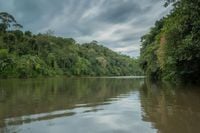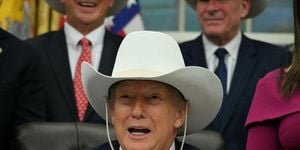As the Amazon rainforest finds itself at the center of global environmental and political attention, a convergence of science, diplomacy, and indigenous stewardship is shaping the future of one of Earth’s most vital ecosystems. On September 23, 2025, Gabriel Escobar, the United States Chargé d’Affaires in Brazil, touched down in Belem—a city poised to host the COP30 climate summit this November. His visit comes at a time when the stakes for Amazon conservation, public health, and international relations have rarely been higher.
Escobar’s arrival is not merely symbolic. The US and Brazil have been navigating choppy diplomatic waters, with recent trade disputes and environmental concerns adding layers of complexity to their relationship. Earlier this year, US President Donald Trump imposed a sweeping 50% tariff on Brazilian goods, specifically targeting products linked to deforestation. The US Trade Representative cited Brazil’s “weak law enforcement in forest management” as a key factor contributing to illegal deforestation, noting that “one-third of Amazonian timber comes from illegal logging.” These moves have rattled Brazilian officials and underscored the global economic consequences of environmental mismanagement.
Yet, amid these tensions, there are signs of hope. Since President Luiz Inácio Lula da Silva’s return to office in 2023, satellite data shows that Amazon deforestation has decreased by nearly 50%. According to SciDev.Net, this progress is set against the backdrop of persistent challenges, with organized crime and illegal land grabbing continuing to fuel environmental destruction in the world’s largest tropical rainforest.
Escobar’s mission in Belem is multifaceted. Beyond diplomatic overtures, his agenda includes meetings with local researchers and non-governmental organizations (NGOs) working on the front lines of conservation. These discussions are expected to explore sustainable practices, conservation strategies, and the very real challenges faced by Amazonian communities grappling with deforestation and environmental degradation.
But what makes the Amazon so critical to both local and global health? Recent research published in Communications Earth and Environment and One Health has shed light on the strategic role of legally recognized Indigenous Territories (ITs) in the Amazon and the Atlantic Forest. By preserving forest coverage and practicing sustainable land management, these territories provide a powerful buffer against respiratory, cardiovascular, and zoonotic diseases—conditions that are often exacerbated by environmental degradation and forest fires.
In a sweeping analysis of 20 years of data across eight Amazonian countries, scientists found that ITs can significantly reduce the incidence of respiratory and cardiovascular diseases associated with fires, especially in regions with high vegetation coverage. However, the relationship isn’t always straightforward. As Paula Prist of the International Union for Conservation of Nature (IUCN) explained, “The protection of ITs is more effective in municipalities that already have an average forest coverage.” The insidious effects of habitat fragmentation can undermine these health benefits, highlighting the delicate balance between conservation and development.
The protective power of Indigenous Territories extends beyond respiratory health. Vector-borne diseases such as malaria, Chagas disease, leishmaniasis, hantavirus, and Rocky Mountain spotted fever are notably less prevalent in areas with traditional indigenous management, particularly where ITs cover more than 40% of the municipal territory. This reduction in disease incidence is not just a boon for local communities—it’s a testament to the value of ancestral knowledge and sustainable practices in public health.
The Atlantic Forest, Brazil’s most degraded biome, offers another striking example. Indigenous Lands here have lost only 1.2% of their vegetation over the past 30 years, compared to a staggering 19.9% on private lands. Although ITs represent just 0.81% of the Atlantic Forest biome, their impact is outsized. As Ana Filipa Palmeirim, a researcher at UFPA, noted, these territories “act as effective barriers against deforestation,” preserving biodiversity and curbing the migration of synanthropic animals—species that thrive in human-altered environments—into urban areas. This, in turn, helps control the spread of vector-borne diseases.
Researchers increasingly advocate for a paradigm shift: recognizing Indigenous Territories not just for their cultural and environmental value, but as “living public health infrastructure.” The ancestral relationship indigenous peoples maintain with their land—rooted in traditional knowledge, social norms, and sustainable practices—offers concrete solutions to the intertwined crises of health and ecology. Vanessa Anny, a professor at UFRR, captured this sentiment succinctly: “There are no healthy people in a sick land. Understanding this respectful relationship is essential to propose new attitudes and build a more balanced connection with the world.”
As the world looks ahead to COP30, Belem is set to become a focal point for global climate action. Escobar’s visit is intended to “build diplomatic bridges ahead of the COP30 summit,” according to SciDev.Net, and to reinforce the US’s commitment to working with Brazil on sustainable development. The summit will bring together leaders, scientists, and advocates from around the globe to hash out solutions for climate change—solutions that will undoubtedly hinge on the fate of the Amazon and its people.
The Amazon’s extraordinary biodiversity also holds promise for sustainable tourism, a potential lifeline for local economies and conservation efforts alike. However, this promise comes with a warning: without strict safeguards, tourism can exacerbate the very environmental destruction it seeks to prevent. Responsible travel—supporting eco-friendly accommodations, wildlife tours, and community engagement—is essential. As SciDev.Net points out, “Tourists are encouraged to support eco-friendly accommodations and wildlife tours that prioritize conservation and community engagement.”
For travelers and policymakers alike, Brazil’s role as one of the world’s most biodiverse nations places it squarely at the heart of global climate discussions. With the eyes of the world on Belem and the Amazon, the outcome of Escobar’s visit—and the broader US-Brazil relationship—may well set the tone for international cooperation on environmental issues for years to come.
The convergence of indigenous stewardship, scientific insight, and diplomatic engagement in the Amazon offers a rare glimmer of hope. By recognizing the invaluable contributions of Indigenous Territories and fostering international collaboration, there’s a real chance to safeguard not only the Amazon’s forests but also the health and well-being of millions who depend on them.




